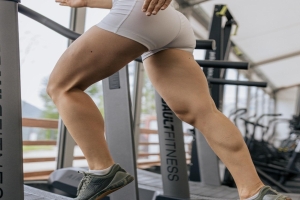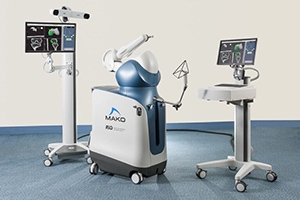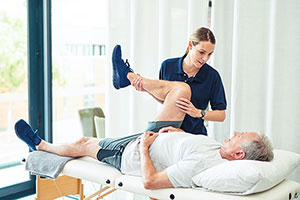Hip flexors are a group of muscles responsible for flexing the hip and raising the legs. These muscles are essential in movement as you use this muscle group every time you stand or take a step; they also help maintain your stability and posture.
It is essential to keep hip flexor muscles strong, given their importance in a person's balance and mobility. If you want to know more about the hip flexor muscles anatomy and how to keep them healthy, then keep reading.
What Are the Hip Flexor Muscles
If you are wondering, “what are the hip flexor muscles,” the first step is understanding its makeup. Hip flexor muscles anatomy is composed of five different muscles, namely:
- Psoas major: A deep muscle that connects the legs to the spine. It runs from the lower back to the pelvis and passes to the front of the hip, where it attaches to the top of the femur (thigh bone).
- Iliacus: This muscle rests deep within the pelvis and attaches to the femur. It is responsible for flexing and rotating the thigh.
- Rectus femoris: This muscle is a part of the quadriceps group, which attaches the pelvis to the knee. Its function, along with the other quadriceps muscles, is to facilitate knee extension.
- Pectineus: Also referred to as the groin muscle, the pectineus rests at the top of the inner thigh.
- Sartorius: This is the longest muscle in the body which spans the hip and knee joints. It is responsible for flexing and moving the knee and leg.
Just like with any other muscle in the body, the hip flexor muscles require regular conditioning to be strong; however, this muscle group is often neglected.
Consequences of Weak Hip Flexor Muscles
Individuals who live a sedentary lifestyle are at a high risk of developing short and tight hip flexors. This is because the muscle group is only activated when standing or moving. Therefore, weak flexor muscles are common in people who sit for extended periods, like those who work in an office.
When you have weak hip flexors, you may experience pain in your lower back, hip and knee due to the overworked joints that compensate for the deficient muscles. You may also experience changes in your posture and gait.
In addition, weak hip flexor muscles are more prone to strain. Once you sustain an injury to your flexors, it can significantly affect your movement and comfort.
Hip Strain Symptoms
The main symptom of a stained or torn hip flexor muscle is a pain in front of the hip where it meets the thigh. The pain level depends on the injury's severity but most often includes swelling, bruising, cramping and muscle spasms.
Hip strain injuries are classified into the following categories:
- Grade 1: Injuries that are mildly painful with minor swelling and tenderness. You can continue your regular activities but with slight discomfort.
- Grade 2: Injuries that involve a more significant tear in the muscle and come with a moderate amount of pain. You can expect a slight loss of function in your legs and knees.
- Grade 3: Injuries involving a complete muscle tear causing severe swelling and pain. Putting weight on the affected leg is impossible, making walking very difficult. With this grade of injury, you can expect to lose more than 50 percent of muscle function in your lower extremities.
Doctors often recommend complete restraint from physical activities following a hip flexor muscle tear to avoid re-injury. It may take two to six months to return to your routine.
Experiencing hip flexor strain and injuries is genuinely troublesome. The good news is that you can avoid them by strengthening your flexor muscles through regular movement and muscle conditioning.
How To Strengthen My Hip Flexors
A strong hip flexor is essential to avoid injury and ensure your overall muscle and postural health. To strengthen this muscle group, you can start with the following stretches and exercises:
Bridge Pose
The bridge pose is famous in yoga because it stretches many parts of the legs, back, and hips while lying down. To perform this, you should lay flat on the ground with your arms on either side of you. Then pull your feet towards the buttocks while keeping the soles of your feet and arms on the floor. Next, lift the buttocks into the air to form a straight line from the knees and shoulders. Hold for 30 seconds, lower and repeat the process.
Lunges
Lunges are one of the most effective exercises to strengthen hip muscles. You can perform this exercise in various ways, but the most common routine is the forward lunge. To execute this, you stand straight with your legs slightly apart. Then, place your hands on the hips and take a big step forward. The heel should make contact with the floor first. Next, bend your knee forward until your thigh is parallel to the floor. Finally, step back into the standing position and repeat with the other leg.
Mountain Climbers
Another great exercise to strengthen the muscles of the hip and legs is mountain climbers. Start in a plank and pull your knee up to your chest. Then quickly alternate between legs until the set is complete. Keep your hands firmly planted on the ground while making these moves.
If you are recovering from a hip flexor injury, it is best to ask a doctor for recommended routines that are safe for your condition.
Consult with the Experts at American Hip Institute
The American Hip Institute is a destination clinic for advanced hip remedies. We have developed unique techniques in Robotic Hip Replacement and stem cell therapies to restore the hip's movement and strength. Contact us today to learn more about how we can help you.




